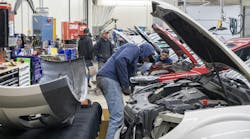Reducing supplements is a key strategy for improving efficiency.
Shop operators know this, which is why the development of repair plans involving vehicle disassembly prior to repair have become widespread in recent years. But a repair plan is only as good as it is accurate.
Photos courtesy Brian Evison and Steven Feltovich
That’s why Brian Evison, the technical director for collision repair consulting firm Bemack Planning Services Inc., has been working with shops to routinely review, or audit, their repair plans. It’s a practice that ultimately leads to improved accuracy, profitability and customer service for both vehicle owners and insurance partners, he says.
Plus, shops that don’t review their plans could be missing out big. Steven Feltovich, manager of business consulting services for Sherwin-Williams, says an accurate repair plan can reduce cycle time 45 to 55 percent, allowing shops to better satisfy customers and get more work completed in less time.
Evison and Feltovich talked with FenderBender about some of the best practices for ensuring that a repair plan provides as much value to a shop as possible.
Getting Started
Evison says supplements will happen, but they should be few and far between. A good goal to shoot for, he says, is one supplement for every 100 estimates. Double-checking repair plans can go a long way toward achieving that goal.
The word “audit” can conjure up negative feelings with business owners and employees alike, but implementing a repair-plan audit is simply a way to check your shop’s estimates. The first step is choosing someone to do the checking.
Evison says someone with intimate knowledge of estimating and estimating systems is an ideal candidate. Someone who has a deep and clear understanding of the repair process can point out potential problems in a plan that wouldn’t be seen by an employee without that intricate knowledge.
it’s just profitability going down the drain. We have to be honest and frank and up front.”
—Brian Evison, technical director,
Bemack Planning Services Inc.
In a small shop, the person would likely be a technician who is not involved with planning a repair. It has to be someone who can spot pitfalls upfront, someone with an eye for detail who can spot any potential problem, so you can avoid supplements.
“You cannot be lacking in this department, otherwise … it’s just profitability going down the drain,” Evison says. “We have to be honest and frank and up front.”
Completing an Audit
There are several ways to check repair plans to make sure they are accurate, Feltovich and Evison say. Any shop, regardless of size, can performa blueprint audit following these steps:
thorough plan:
Use a checklist. Feltovich says Sherwin-Williams created a checklist that shops can use. On the two-sided list, the first side shows damage broken into categories: primary, secondary and mechanical damage. The backside explains indirect damage that can be easily missed, such as a crushed dash panel caused by the impact of a person’s knees.
“It keeps you abreast to make sure you have an accurate estimate,” Feltovich says of the checklist. “It’s all about accuracy.”
Try a paperless audit. Evison has a different approach. He doesn’t like to know what has been done before he goes to audit a repair plan. He looks at the vehicle and then compares his ideas of what needs to be done with the technician’s findings.
“When I’m auditing, I don’t even look at the blueprint. I’m going straight in. They’ve missed something, they don’t know what it is, but I’m going to find it,” he says. “I try not to be influenced by what’s already been written.”
Check before parts are ordered. When someone has gone over a vehicle like a crime scene and visualized the process, but hasn’t yet ordered parts, “that’s the time for auditing,” Evison says. A complete audit will prevent multiple parts orders.
Audit afterward. Check accuracy of work by counting supplements. Over time, shops can see common threads of the types of repairs that are needed, but missed in the initial stages of fixing a vehicle.
Words of Wisdom
Evison and Feltovich say many insurance companies don’t always want a complete repair plan because it costs more money. “They would much [rather] us just write an estimate,” Evison says.
But the problem with that is that someone forgets certain aspects of the repair process, such as transmission fluids, lubricants or cooling system fluid. Then shops end up eating the costs of the parts and labor.
Completing a thorough repair plan, and then auditing it, also requires discipline, Evison says. Most wasted time in the repair process is the result of something missed up front.
Auditing takes minimal time considering the potential errors it eliminates. Feltovich says it usually takes no more than 15 minutes to complete the self-auditing checklist, but the hard work is in critical, thorough thinking about a repair plan.
He also says that it is key to have a shop culture where people understand why it is important to complete a thorough and accurate estimate. If they know why, and buy in to the process, then they won’t just check a box on a list to appease their manager. There’s no point in having checklists or any specific process if a worker simply goes through the motions.
The bottom line is the customer, Feltovich says. An accurate repair plan not only brings value to you, he says, but also the customer, who writes your paychecks each day.



